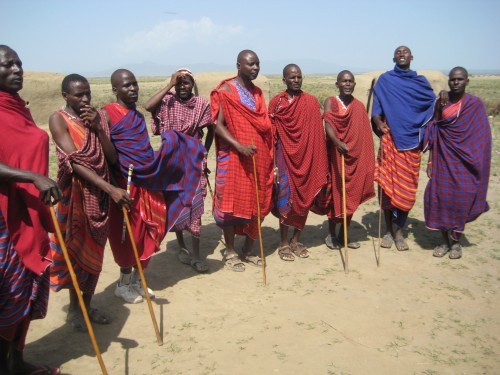The Maasai, a tribe in Tanzania
On my third day in Moshi, the base for the Kilimanjaro hike, I decided to visit a Maasai Boma to better understand one of the largest ethnic groups in Tanzania. I was on this tour by myself with a guide so it was perfect. It felt less like a tourist trap and I had some quality time with the tribe, with my guide being the translator.
 The Maasai are a very distinctive semi-nomadic, patriarchal tribe in Tanzania. Known as warriors, the basis of their culture is to raise cattle. Over the many years, the Maasai have become very good at raising cattle, in addition to other animals (calves, lambs, etc). The tribe who originated in the Nile region began migrating to the South (Kenya and Tanzania) in the 15th century. When some of them settled by Mount Kilimanjaro, other tribes were already there. For example, the Pare settled by Kilimanjaro and tension rose when the Maasai cattle were eating the gardens of the Pare.
The Maasai are a very distinctive semi-nomadic, patriarchal tribe in Tanzania. Known as warriors, the basis of their culture is to raise cattle. Over the many years, the Maasai have become very good at raising cattle, in addition to other animals (calves, lambs, etc). The tribe who originated in the Nile region began migrating to the South (Kenya and Tanzania) in the 15th century. When some of them settled by Mount Kilimanjaro, other tribes were already there. For example, the Pare settled by Kilimanjaro and tension rose when the Maasai cattle were eating the gardens of the Pare.
When I arrived to their village, I was very welcomed by the family and they immediately took me to one of their huts to dress me like a Maasai. The Maasai wrap a cloth on the bodies, which go over their shoulders. Men wear red because it represents warriors, blood and bravery. The women wear mainly blue because it represents peace. You can additionally find other colors and patterns but these are the most common and popular. I noticed that most Maasai have a hole in their earlobe. It’s an older custom that younger ones don’t necessarily follow anymore but a hole is pierced so that they can wear beaded jewelry. The women are responsible for making the jewelry, which are mainly made of colorful beads. Very simple but pretty.
After being dressed up like a Maasai, the family gathered in a circle and began dancing. The basis of their dancing is to jump. The men will jump up and down while standing very straight. It represents them getting ready to hunt a lion, a stage that occurs right before the man gets circumcised. With the ban of lion hunting and better education, it’s not as common as it was before. They make different types of sounds with their mouths which all come together harmoniously. It was long after they began dancing that they came to grab me to dance. I was shy at first but then again, there was no one else around and being part of such an event was awesome. So I embraced it!
After some dancing, I went in another one of their huts to be informed about the culture. I learned that the women are responsible for building houses, cooking and raising the children. Men are responsible for raising animals and protecting the family. Houses are built with material found in the area. It normally takes about 4 to 6 months for a woman to build the house. The hut looking homes are very small but comprise a place to put the animal (s), a kitchen and a bed. Under the “mattress” of the bed, they put mint leaves to keep mosquitoes away. The children sleep in a different hut with other kids until they are a few years old, where they’ll then move with the parents.
The Maasai kept their old traditions, even though the Tanzanian government has encouraged them to abandon their semi-nomadic lifestyles and assimilate to the rest of the population. They are easily recognizable when visiting Tanzania. You learn to appreciate them!





Comments (1)